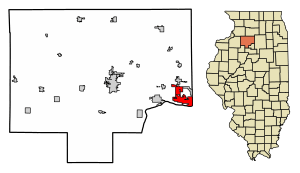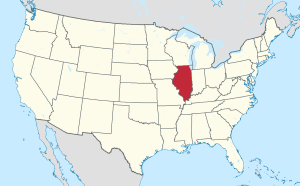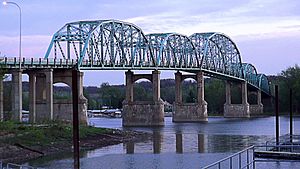Spring Valley, Illinois facts for kids
Quick facts for kids
Spring Valley
|
|
|---|---|
| Nickname(s):
The Valley
|
|

Location of Spring Valley in Bureau County, Illinois.
|
|

Location of Illinois in the United States
|
|
| Country | United States |
| State | Illinois |
| County | Bureau |
| Township | Hall |
| Area | |
| • Total | 7.40 sq mi (19.17 km2) |
| • Land | 7.36 sq mi (19.06 km2) |
| • Water | 0.04 sq mi (0.10 km2) |
| Population
(2020)
|
|
| • Total | 5,582 |
| • Density | 754.3/sq mi (291.18/km2) |
| Time zone | UTC-6 (CST) |
| • Summer (DST) | UTC-5 (CDT) |
| ZIP Code(s) |
61362
|
| Area code(s) | 815 |
| FIPS code | 17-72156 |
| Wikimedia Commons | Spring Valley, Illinois |
Spring Valley is a city in Illinois, United States. It is located in Bureau County, right by the Illinois River. In 2020, about 5,582 people lived there. The city is sometimes called "The Valley."
Contents
Where is Spring Valley?
Spring Valley is located at 41°19′38″N 89°12′3″W / 41.32722°N 89.20083°W. It covers an area of about 7.40 square miles (19.17 square kilometers). Most of this area is land, with a small part being water.
How Many People Live Here?
| Historical population | |||
|---|---|---|---|
| Census | Pop. | %± | |
| 1890 | 3,837 | — | |
| 1900 | 6,214 | 61.9% | |
| 1910 | 7,035 | 13.2% | |
| 1920 | 6,493 | −7.7% | |
| 1930 | 5,270 | −18.8% | |
| 1940 | 5,010 | −4.9% | |
| 1950 | 4,916 | −1.9% | |
| 1960 | 5,371 | 9.3% | |
| 1970 | 5,605 | 4.4% | |
| 1980 | 5,822 | 3.9% | |
| 1990 | 5,246 | −9.9% | |
| 2000 | 5,398 | 2.9% | |
| 2010 | 5,558 | 3.0% | |
| 2020 | 5,582 | 0.4% | |
| U.S. Decennial Census | |||
In 2020, the city had 5,582 residents living in 2,221 households. About 25.7% of these households had children under 18. The average age of people living in Spring Valley was 43.8 years.
People from many different backgrounds live in Spring Valley. About 79.34% of the residents were White, and 18.70% were Hispanic or Latino. Other groups included African American, Native American, and Asian residents.
Why is it Called Spring Valley?
The name "Spring Valley" makes a lot of sense when you learn about the area. The city is in a valley, and there used to be many natural springs flowing from the hills into a stream called Spring Creek.
These springs were important. One large spring was so big that Native American people used to camp there. The first drinking water for the town also came from these springs. The local Native Americans even called this area "The Valley of the Springs."
The narrow part of the river valley here is also a great spot for storing grain. This has made Spring Valley a key place for handling grain along the Illinois River.
Spring Valley's Past
Spring Valley was started in 1884. It was built specifically for coal mining. Two men, Henry J. Miller and Charles J. Devlin, had the idea to create a big coal town. They bought land and got help from wealthy people involved in coal and railroads.
Coal Mining Town
The town was carefully planned, not just built randomly. They set aside space for churches, schools, and public buildings. Wide streets were laid out, like St. Paul Street, which is one of the widest in Illinois.
Spring Valley grew very quickly and was even called the "Magic City." In just four years, by 1888, a railroad line was built, four coal mines were opened, and the town had 3,000 people.
Many Cultures
Like many coal towns, Spring Valley became home to people from many different countries in Europe. Miners came from England, Scotland, Ireland, Wales, France, Belgium, Poland, Germany, Sweden, Lithuania, and Italy. Many arrived wearing their traditional clothes. There was also a section of town known as "the Location" where Black residents lived. In 1905, a local newspaper said that 32 different groups of people lived in Spring Valley!
Early Institutions
Just two years after Spring Valley became an official town in 1886, many important places were built:
- Two churches: Congregational and Immaculate Conception.
- Two schools: Immaculate Conception Parochial and Lincoln Public School (which included a high school).
- A newspaper: The Spring Valley Gazette.
- A public library: This library was started by the "Knights of Labor," a coal miner's union, in 1885. This was even before the town was a year old or had a city government!
This early focus on education led to the creation of the Hall Township High and Vocational School in 1914. This school offered training in many useful skills like shop, carpentry, printing, cooking, sewing, and typing.
Getting Around
Spring Valley does not have its own local bus service. However, you can find intercity bus service provided by Burlington Trailways in nearby Peru.
Famous People from Spring Valley
- Brian Allard – A pitcher in Major League Baseball (MLB).
- Chad Durbin – A relief pitcher for several MLB teams and a World Series champion in 2008. He was born in Spring Valley.
- Joe Krabbenhoft – A basketball player and coach at the University of Wisconsin.
- Alixa Naff – A historian who studied Arab American immigration.
- Billy Papke – A world middleweight boxing champion in 1908.
Images for kids
See also
 In Spanish: Spring Valley (Illinois) para niños
In Spanish: Spring Valley (Illinois) para niños




